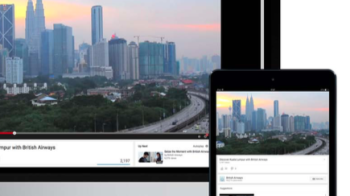Getting mobile video right
Tal Chalozin
Tal Chalozin, CTO & Co-founder of Innovid, explains that creating video, and more importantly advertising content, in the right format is key.
This year marks 90 years since the first public demonstration of live television. Since then, we’ve seen a new wave of mobile, tablet and a whole host of other devices that have revolutionised the way video is now viewed and created.
Before mobile was born, video and TV content was created responsively; it didn’t matter what type of TV the content was being viewed on, whether it be a standard definition TV, high-definition TV, small screen or big screen. However, the introduction of mobile devices complicated this somewhat; both the smaller screens and the ability to watch video on the move means that more consideration needs to be put into not just the type of content, but how the video is displayed and created.
With the lesser-adopted vertical video now creating a storm, engagement across multiple channels to consider and personalisation to prepare for, producing appealing content for consumers in the right format has never appeared more complex. However, as Tal explains, with a clear understanding of all the elements, there is no reason not to create video content that leaves consumers wanting more.
1. Vertical vs horizontal
Think about the video that you currently view on mobile, most likely on a daily basis. When you pick up your phone, how are you holding it? Research shows that users hold their phones vertically 94% of the time, meaning that videos that aren’t created in this format are viewed with huge black spaces at the top and bottom of the screen. This creates big problems for content consumption, as the user is left with the choice of either zooming in on the video and missing out on content, or viewing the video in a much smaller format, meaning the experience of viewing video across devices becomes fragmented and misaligned.
So why aren’t content creators rushing to create videos that are vertical-friendly? Indeed, some channels such as Snapchat are already only allowing video content creation in vertical format. However, creating vertical video does require a different mind-set; with a seemingly complex creation and editing process that is vastly different to creating videos in other formats. However, with the user experience at stake, adapting to vertical videos and following the likes of Snapchat should be a question of when, rather than if.
2. Make it interactive
With mobile set to drive a 19.8% increase in online video consumption, it is no wonder many brands are putting this marketing and advertising tool at the forefront of their digital strategies. However, video is only one part of a wider campaign and can often lack direct engagement, instead acting as a static viewing tool. By adding an interactive element, video can help viewers to make informed decisions and even become a direct path to purchase. Simple executions such as "Buy It Now" buttons, product recommendations, or store locators can quickly transform a once-passive medium into an instant e-commerce experience.
Additionally, integrating the growing presence of social media into a campaign can also significantly drive interaction and encourage users to share their experiences amongst friends and followers; driving reach and increasing engagement.
3. Prepare for personal
Consumers always expect to be served the best possible experience. An interactive, vertically aligned video experience on mobile is great; however, consumers want this taken one step further with an experience that is tailored to them, too. By optimising videos that leverage data such as location and weather targeting, consumers can experience content that is not only more relevant, but also relates to them in real-time. And it needn’t be complicated either.
With multiple options to consider when creating video for mobile, it is clear that mobile video ads are finally coming into their own. Keeping pace with the technological changes that have already happened and that are set to continue is vital in this field; marketers, advertisers and developers that don’t adapt will simply risk losing out. Consumers know what they want from brands, and they won’t be satisfied until they get it.
Related content
CEDAR: Video Content Marketing
Learn moreHumanising interactions with consumers across screens
Learn moreCreative Pick: Hotels.com
Learn morePinterest launches promoted videos
Learn more
Rediscover the joy of digital advertising
Champion connections instead of clicks. Capture audiences' imaginations, not just their attention. Boldly find your own beat instead of letting tech set the pace. It’s time to rediscover the joy of digital.



